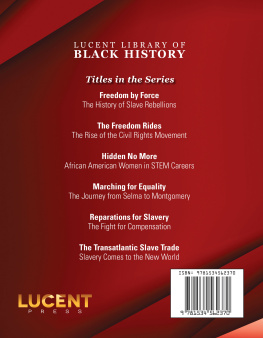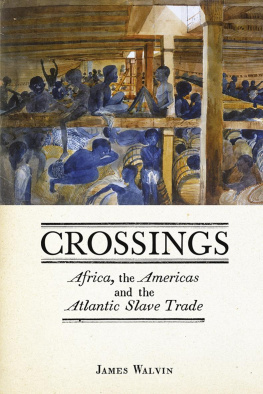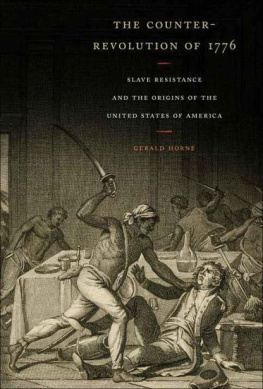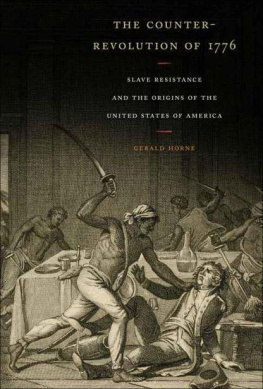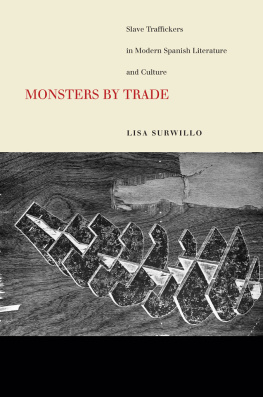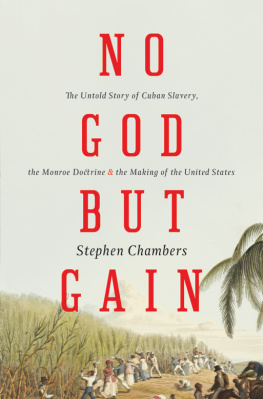Leonardo Marques - The United States and the Transatlantic Slave Trade to the Americas, 1776-1867
Here you can read online Leonardo Marques - The United States and the Transatlantic Slave Trade to the Americas, 1776-1867 full text of the book (entire story) in english for free. Download pdf and epub, get meaning, cover and reviews about this ebook. year: 2016, publisher: Yale University Press, genre: History. Description of the work, (preface) as well as reviews are available. Best literature library LitArk.com created for fans of good reading and offers a wide selection of genres:
Romance novel
Science fiction
Adventure
Detective
Science
History
Home and family
Prose
Art
Politics
Computer
Non-fiction
Religion
Business
Children
Humor
Choose a favorite category and find really read worthwhile books. Enjoy immersion in the world of imagination, feel the emotions of the characters or learn something new for yourself, make an fascinating discovery.

- Book:The United States and the Transatlantic Slave Trade to the Americas, 1776-1867
- Author:
- Publisher:Yale University Press
- Genre:
- Year:2016
- Rating:3 / 5
- Favourites:Add to favourites
- Your mark:
- 60
- 1
- 2
- 3
- 4
- 5
The United States and the Transatlantic Slave Trade to the Americas, 1776-1867: summary, description and annotation
We offer to read an annotation, description, summary or preface (depends on what the author of the book "The United States and the Transatlantic Slave Trade to the Americas, 1776-1867" wrote himself). If you haven't found the necessary information about the book — write in the comments, we will try to find it.
Leonardo Marques: author's other books
Who wrote The United States and the Transatlantic Slave Trade to the Americas, 1776-1867? Find out the surname, the name of the author of the book and a list of all author's works by series.
The United States and the Transatlantic Slave Trade to the Americas, 1776-1867 — read online for free the complete book (whole text) full work
Below is the text of the book, divided by pages. System saving the place of the last page read, allows you to conveniently read the book "The United States and the Transatlantic Slave Trade to the Americas, 1776-1867" online for free, without having to search again every time where you left off. Put a bookmark, and you can go to the page where you finished reading at any time.
Font size:
Interval:
Bookmark:
The United States and the Transatlantic Slave Trade to the Americas, 17761867
The United States and the Transatlantic Slave Trade to the Americas, 17761867
LEONARDO MARQUES

Published with assistance from the Annie Burr Lewis Fund and from the foundation established in memory of Calvin Chapin of the Class of 1788, Yale College.
Copyright 2016 by Leonardo Marques.
All rights reserved.
This book may not be reproduced, in whole or in part, including illustrations, in any form (beyond that copying permitted by Sections 10 and 108 of the US Copyright Law and except by reviewers for the public press), without written permission from the publishers.
Yale University Press books may be purchased in quantity for educational, business, or promotional use. For information, please e-mail (UK office).
Set in Minion type by Integrated Publishing Solutions.
Printed in the United States of America.
Library of Congress Control Number: 2016942711
ISBN 978-0-300-21241-9 (hardcover)
A catalogue record for this book is available from the British Library.
This paper meets the requirements of ANSI/NISO Z39.481992 (Permanence of Paper).
10 9 8 7 6 5 4 3 2 1
To Iraci
T his book is a revised version of my PhD dissertation, defended at Emory University in 2013. I therefore start by thanking the many colleagues, friends, and professors I have met and learned from since 2007 at Emory. A very special thanks goes to David Eltis, whom I had the honor of having as an adviser and friend. It is impossible to describe how much I have learned from him over the years. This book would not exist without his mentorship. James Roark and Thomas Rogers read a previous version of this work and provided invaluable comments. I cannot thank them enough for all their help over the years. Susan Socolow is one of the greatest professors I ever had, and I thank her for everything she has done for me. Nafees Khan, Rachel Lambrecht, Brad Lange, Joe Renouard, and Cari Williams have not only helped me with various issues, but have also been fantastic friends. Thanks also to Sarita Alami, Marcy Alexander, Patrick Allitt, Alex Borucki, Barb Brandt, Erica Bruchko, Richard Cook, Joe Crespino, Robert Desrocher, Daniel Domingues, Bob Elder, Melissa Faris Gayan, George Kientzy, Steve Lamb, Jeffrey Lesser, Kristin Mann, Phil Misevich, Francis Musoni, Alex Neundorf, Craig Perry, Fabrcio Prado, Bianca Premo, Marina Rustow, Andrea Scionti, Elizabeth Stice, Patricia Stockbridge, Lena Suk, Ariel Svarch, Jorge Troisi-Melean, Juan Viacava, Katie Wilson, and Steve Witte.
Before I attended Emory, I had the honor to study with and learn from a number of people at the Universidade Federal do Paran and at the University of North Carolina at Charlotte. I must start by thanking my first adviser, Carlos Alberto Medeiros Lima, to whom I owe eternal gratitude. I also wish to thank Rafael Benthien, Luiz Adriano Borges, Mabel Borges, Hilton Costa, Cesar Cundari, Rogrio Cunha, Rodrigo Gonalves, Maria Thereza David Joo, Athos Maia, Ana Paula Vosne Martins, Allan de Paula Oliveira, Jonas Pegoraro, Jos Roberto Braga Portella, Claudio Guga Rovel, Helder Cyrelli de Souza, Luiz Geraldo Silva, Rodrigo Turin, and Bruno Zorek. A very special thanks goes to my good old friend Bruno Santos Alexandre, who has actually read parts of this work and with whom I have had regular discussions on a number of issues. At UNC Charlotte I had the honor of studying with Lyman Johnson, Robert Smith, and the same Thomas Rogers. I cannot thank them enough. A special thanks goes to Martha LaFollette Miller.
In recent years I had the opportunity to discuss this work with a number of people at Brown University and at the Universidade de So Paulo. I would like to thank Valerie Andrews, Paula Dias, Natalie Deibel, Alexandre Dub, Kittya Lee, Derek Miller, Margot Nishimura, Marcy Norton, Kimberly Nusco, Gabriel Paquette, Seth Rockman, Ken Ward, and Ted Widmer. Nancy Kougeas was especially helpful during my research at Bristol. In So Paulo, I thank Rafael Marquese and Tmis Parron for their friendship and great discussions, which were fundamental for many of the arguments developed in this book. Gabriel Aladrn, Fernanda Bretones, Marcelo Ferraro, Marco Holtz, and Priscila Lima, Waldomiro Jr., and Alain Youssef read parts of this work and helped me improve it. I also thank Joo Paulo Pimenta and the members of the Lab-Mundi at USP.
Andr Luiz Bertoli, Ida Camila Dantas Granja, Andrei Dignart, Elisa Freitas, Marcy, Laura and Felipe Marques, and Kenny, Cari, Miles, and Georgia Maes received me in their homes during research trips to Providence, Bristol, Rio de Janeiro, Piracicaba, and Lisbon, and for this Ill be forever thankful.
I thank Marcos Abreu, Lorena Avellar, Edward Baptist, Sarah Batterson, Celso Castilho, Stephen Chambers, Luiz Alberto Couceiro, Aisnara Perera Daz, Carlos and Bia Dignart, Seymour Drescher, Sharla Fett, Joo Escosteguy Filho, Frederico Freitas, Fbio Frizzo, Mara de los ngeles Merio Fuentes, Graciela Garcia, Tiago Gil, Dale Graden, Mariana Guglielmo Martha Hameister, John Harris, Richard Huzzey, Anthony Kaye, Jos Knust, Thiago Krause, Marcia Kuniochi, Jane Landers, Thiago C.P. Loureno, Beatriz Mamigonian, Katherine Marino, Karl Monsma, Mariana Muaze, Paulo Henrique Pach, Walter Luiz Pereira, Ian Read, Ricardo Salles, Yna Lopes dos Santos, Lise Sedrez, Rejane Valvano Silva, Dale Tomich, Oscar de la Torre, Marial Iglesias Utset, Scott Webster, David Wheat, Nicholas Wood, Michael Zeuske, the Felix and Peixoto families, Derry, Marcy, and all the people at the Bristol Historical and Preservation Society, the John Carter Brown Library, the National Archives at Atlanta, the National Archives at Boston, the Rhode Island Historical Society, the Arquivo Nacional do Rio de Janeiro, the Arquivo do Itamaraty, the British National Archives, the Arquivo Histrico-Diplomtico at Lisbon, the Arquivo Nacional da Torre do Tombo, the Emory Laney Graduate School, and the Santos Futebol Clube.
Since 2015, I have had the chance to meet and work with a number of great colleagues and students at the Universidade Federal Fluminense. I thank them for receiving me so well. A special thanks goes to Maria Vernica Secreto Ferreras, Norberto Osvaldo Ferreras, Renato Jnio Franco, Jonis Freire, Carlos Gabriel Guimares, Alexandre Santos de Moraes, Silvia Patuzzi, Ronald Raminelli, Alexandre Vieira Ribeiro, Giselle Martins Venncio, Carlos Eduardo Valencia Villa, and Marcelo da Rocha Wanderley.
A very special thanks also goes to Chris Rogers, Erica Hanson, Kristy Cottrell, Laura Jones Dooley, and everyone at Yale University Press who made this book possible.
Last, I thank my family, starting with my mother, Iraci Mailde Ramos, without whom none of this would have been possible, and Gisele Batista Candido, who was literally by my side during the writing of this book. Infinite love for these two. I also thank the entire Marques, Batista, and Candido families, Jalmar, Jalmara, and Prsio Torres, and all my friends in Brazil and the United States. Unfortunately, Joo Ramos da Silva Filho, Antnio Augusto Marques, Milce Mailde Marques, and Luz Candido did not live long enough to see this book in print, but I wish to acknowledge my gratitude for having had them in my life.
Introduction
I n 1841, an Englishman and his American friend, John Gardiner, decided to unearth the grave of James DWolf in Bristol, Rhode Island. Having arrived that year in the country, the Englishman learned about the deceased man after attending a lecture against slavery given by a visiting abolitionist woman. There he learned that DWolf had worked at a young age as mate onboard a vessel engaged in the transatlantic slave trade and that, after becoming its captain, he accumulated property rapidly, until he became very rich and owned large plantations in the Island of Cuba. According to legend, DWolf later became associated with Charles Gibbs, a Rhode Island pirate who captured a vessel leaving Spanish America for Europe with seven coffins of silver. James DWolf was alleged to have been buried in one of these.
Next pageFont size:
Interval:
Bookmark:
Similar books «The United States and the Transatlantic Slave Trade to the Americas, 1776-1867»
Look at similar books to The United States and the Transatlantic Slave Trade to the Americas, 1776-1867. We have selected literature similar in name and meaning in the hope of providing readers with more options to find new, interesting, not yet read works.
Discussion, reviews of the book The United States and the Transatlantic Slave Trade to the Americas, 1776-1867 and just readers' own opinions. Leave your comments, write what you think about the work, its meaning or the main characters. Specify what exactly you liked and what you didn't like, and why you think so.

